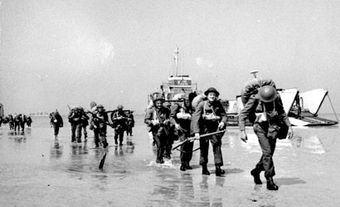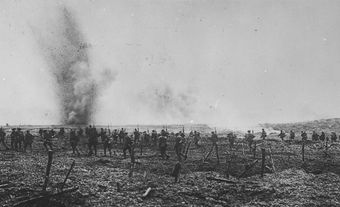
Early Life
Oliver Martin was one of seven children born to Robert and Lucinda “Lucy” Martin (nee Miller). His early education was at a school on the Six Nations of the Grand River First Nation and Caledonia High School. With so many children in the family, Martin left home as a teenager and found work in a drugstore in Rochester, New York. A desire to teach and the persuasion of a friend convinced him to return to Canada. Martin graduated from Normal School (teacher’s college) and began teaching. In 1909, he joined the 37th Regiment Haldimand Rifles, a local militia unit, as a bugler. Martin served with the unit for three years and was commissioned as a lieutenant.
First World War
On 9 February 1916, Oliver Martin enrolled in the 114th (Brock’s Rangers) Battalion, Canadian Expeditionary Force as a lieutenant. The unit had been recruited in Haldimand County and received its secondary title in honour of the Indigenous warriors from the Grand River region who fought beside Major-General Sir Isaac Brock during the War of 1812. Martin sailed from Halifax with the battalion on 31 October 1916 and arrived at Liverpool, England, on 11 November. The 114th Battalion was broken up shortly after arrival in England and its soldiers sent to various units as reinforcements. (See also Indigenous Peoples and the First World War.)
In January 1917, after brief attachments to other battalions, Martin was posted to the 107th (Timber Wolf) Battalion. The 107th Battalion had been raised in Western Canada and contained several Indigenous soldiers. It was redesignated as a pioneer unit in England before it was sent to France in March 1917. Martin served there and in Belgium for seven months. Later that year, he survived a gas attack in Belgium. In September, Martin was attached as a probationary observer with the Royal Flying Corps and sent on a month-long observer’s course in England.
Shortly after, he was admitted to 1st Northern General Hospital in Newcastle upon Tyne complaining of urinary, knee and hip pain. While in Newcastle, he married Irene Preece, with whom he had a daughter in 1918. Martin also spent time in Granville Special Hospital in Kent and the convalescent hospital in Matlock Bath while recovering from his medical problems. In June 1918, he was attached to No. 1 School of Aeronautics in Reading, where he earned his Royal Air Force pilot’s wings.
Between the Wars
After repatriation to Canada in July 1919, Oliver Martin applied for federal government funding designated for Indigenous people so he could attend university but was unsuccessful. He then tried to put himself through the University of Toronto but returned to teaching in 1922. He first taught at Secord School in East York, a Toronto suburb. Martin and Irene divorced in the early 1920s, and she returned to England with their daughter. Martin continued to teach at Secord until 1936. While there, he married fellow teacher Lillian Bunt in 1936, but they had no children. Martin went on to become the principal of the nearby Danforth Park School.
Martin also rejoined his old prewar militia unit, the Haldimand Rifles. He rose through the officer ranks and assumed command in 1930 as a lieutenant-colonel. In 1936, the Haldimand Rifles amalgamated with the Dufferin Rifles to form the Dufferin and Haldimand Rifles of Canada. Martin remained as commanding officer of the new unit until the outbreak of the Second World War in 1939.
Second World War
Oliver Martin remained in Canada during the Second World War and led three home defence brigades. He commanded 13th Infantry Brigade as a colonel while it underwent training at Niagara-on-the-Lake from June 1940 to August 1941. The brigade was then sent to Vancouver Island over fears of a Japanese invasion after the attack on Pearl Harbor, Hawaii, on 7 December 1941. Promoted brigadier in 1941, Martin was also sent to the West Coast. He commanded 18th Infantry Brigade at Nanaimo, BC, between August 1941 and May 1942, followed by 16th Infantry Brigade at Prince George, BC, from May 1942 to July 1943. His last appointment was in command of troops in Military District No. 2 in Ontario. Martin retired from the army in October 1944. (See also Indigenous Peoples in the Second World War.)

Post-War
In 1944, after he left the army, the government of Ontario appointed Oliver Martin as provincial magistrate for York, Halton and Peel Counties, collectively known as District 6. He was the first Indigenous individual to hold a judicial post in the province. In 1953, Martin and his wife attended the coronation of Queen Elizabeth II as invited guests. He died in hospital in 1957 following an operation and is buried in the veteran’s section of the Pine Hills Cemetery in Scarborough, Ontario.
Significance and Recognition
As the first Indigenous person to be promoted brigadier (known as brigadier-general since 1968) and appointed provincial magistrate, Martin was a trailblazer, and most discussions and lists of prominent Indigenous people in Canada include his name. He was made a member of the Indian Hall of Fame, a display created at the Canadian National Exhibition to honour Indigenous people that ran for several years. In his honour, the Royal Canadian Legion named Branch No. 345 in East York the Brigadier O.M. Martin Branch.

 Share on Facebook
Share on Facebook Share on X
Share on X Share by Email
Share by Email Share on Google Classroom
Share on Google Classroom











